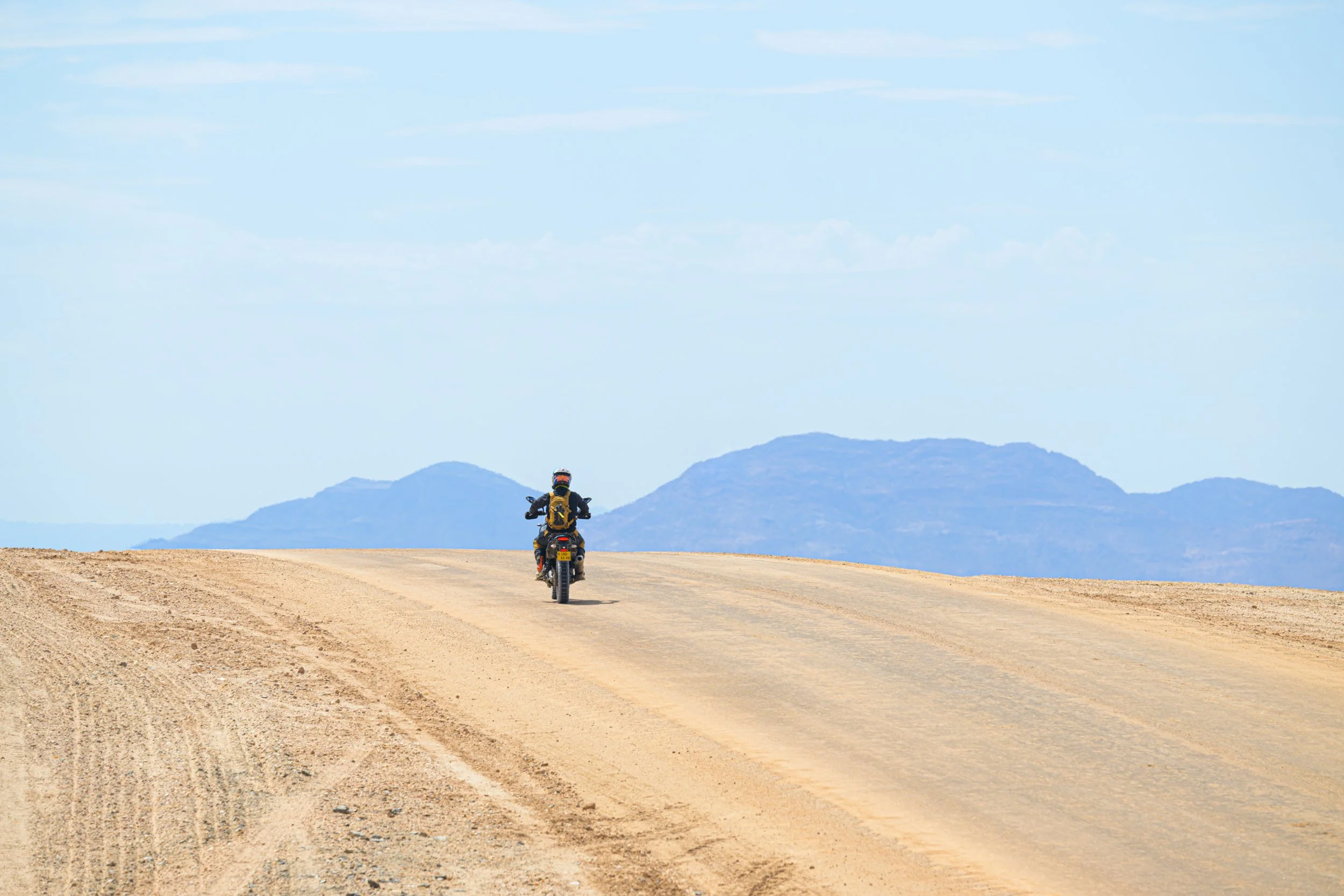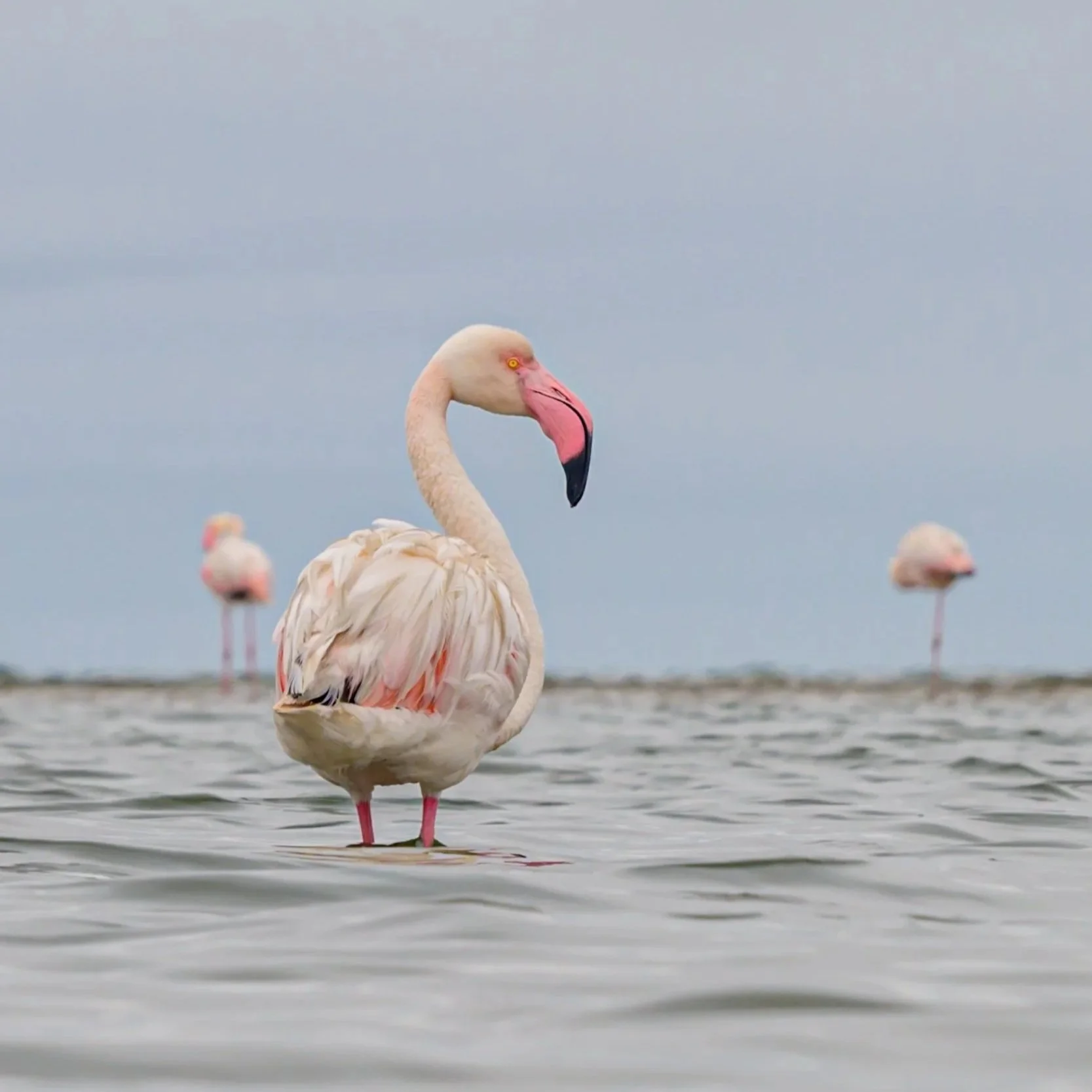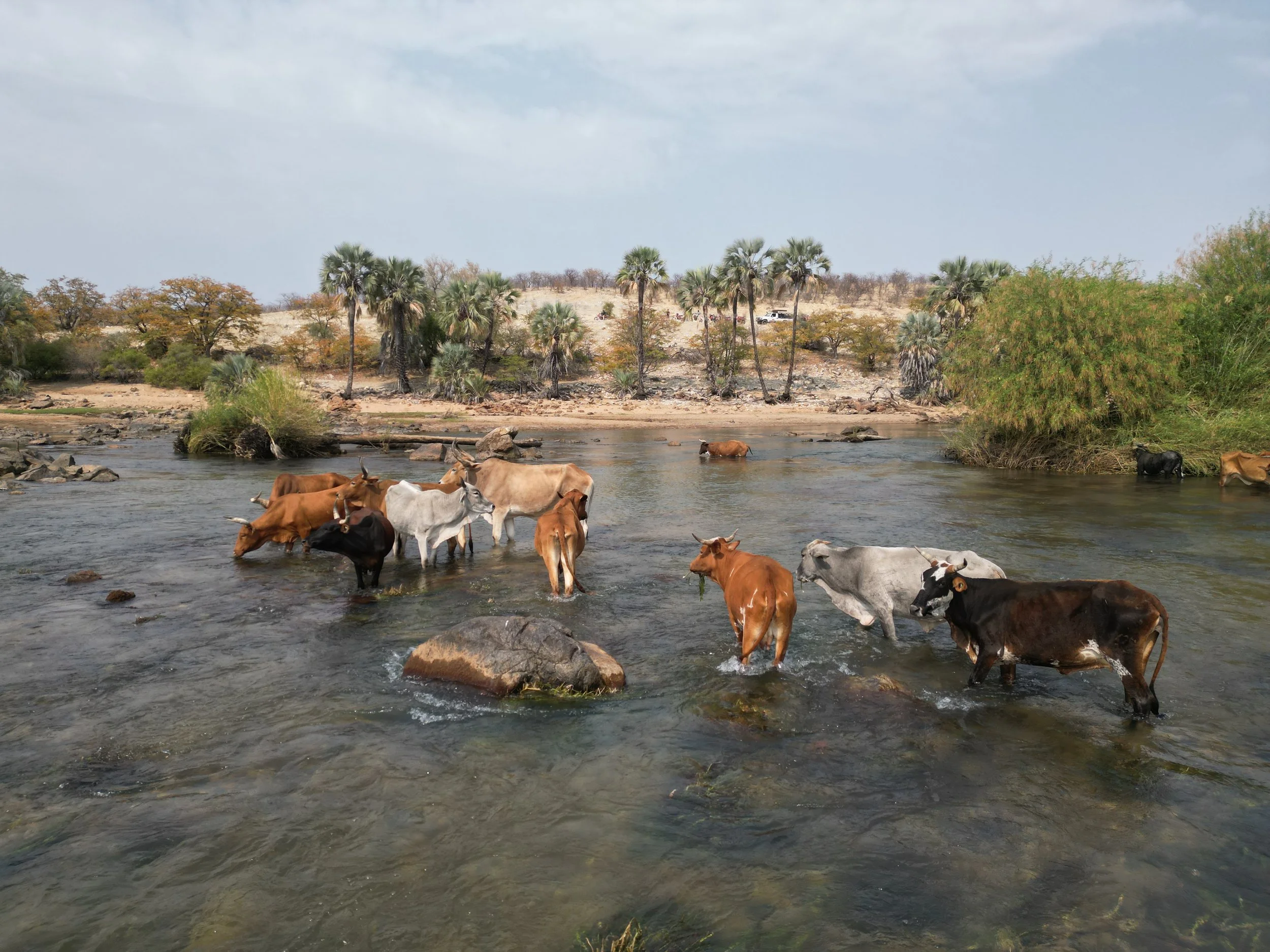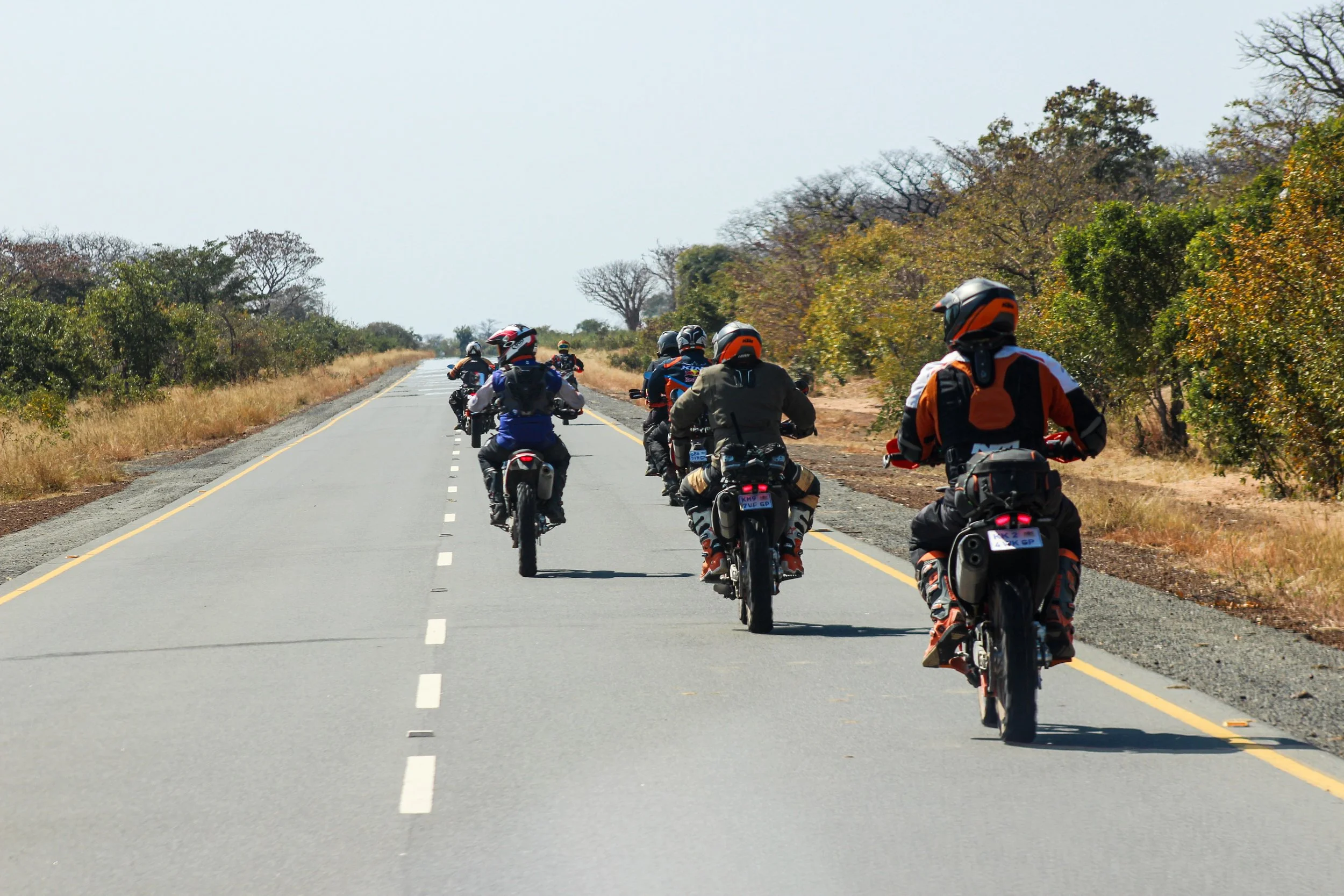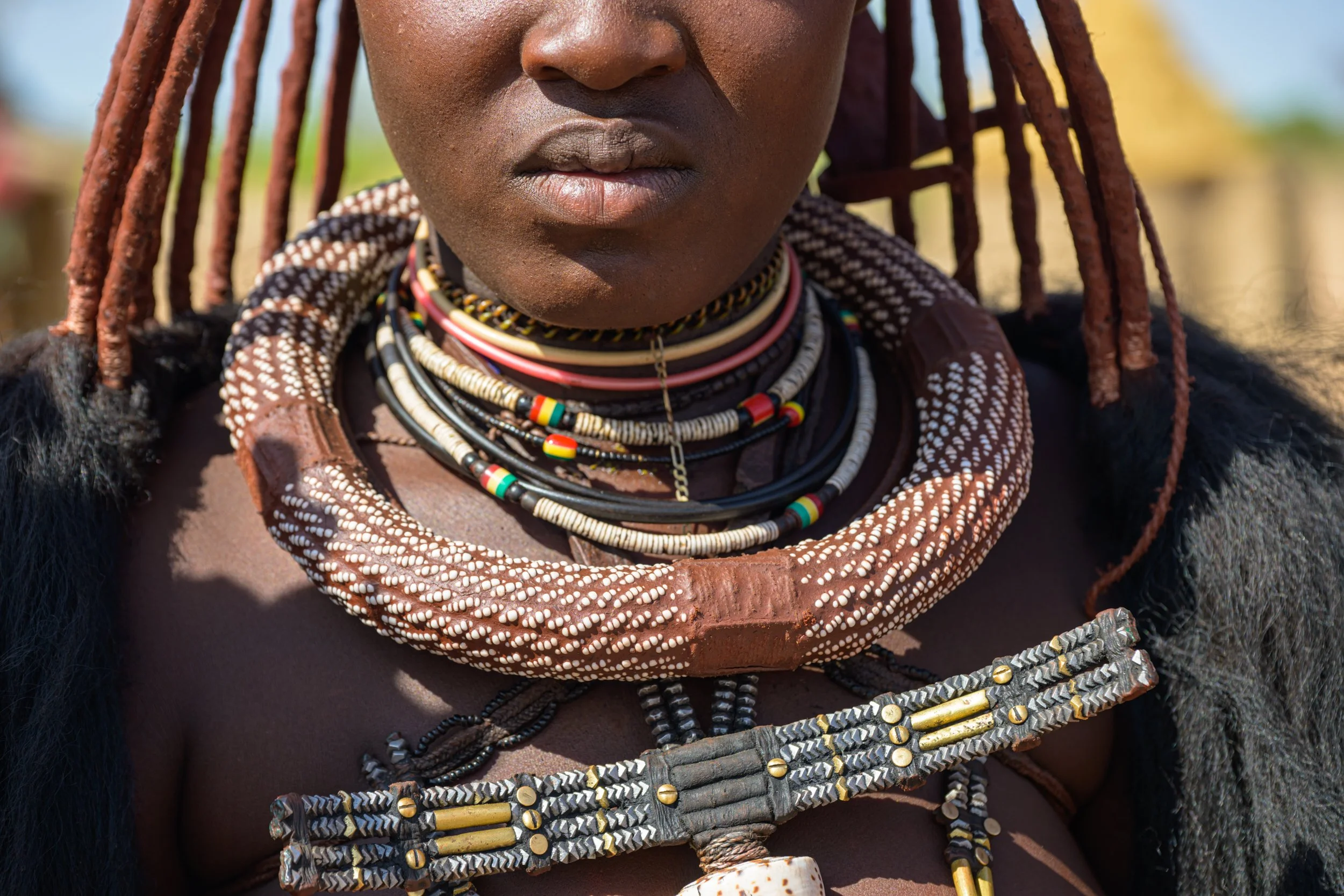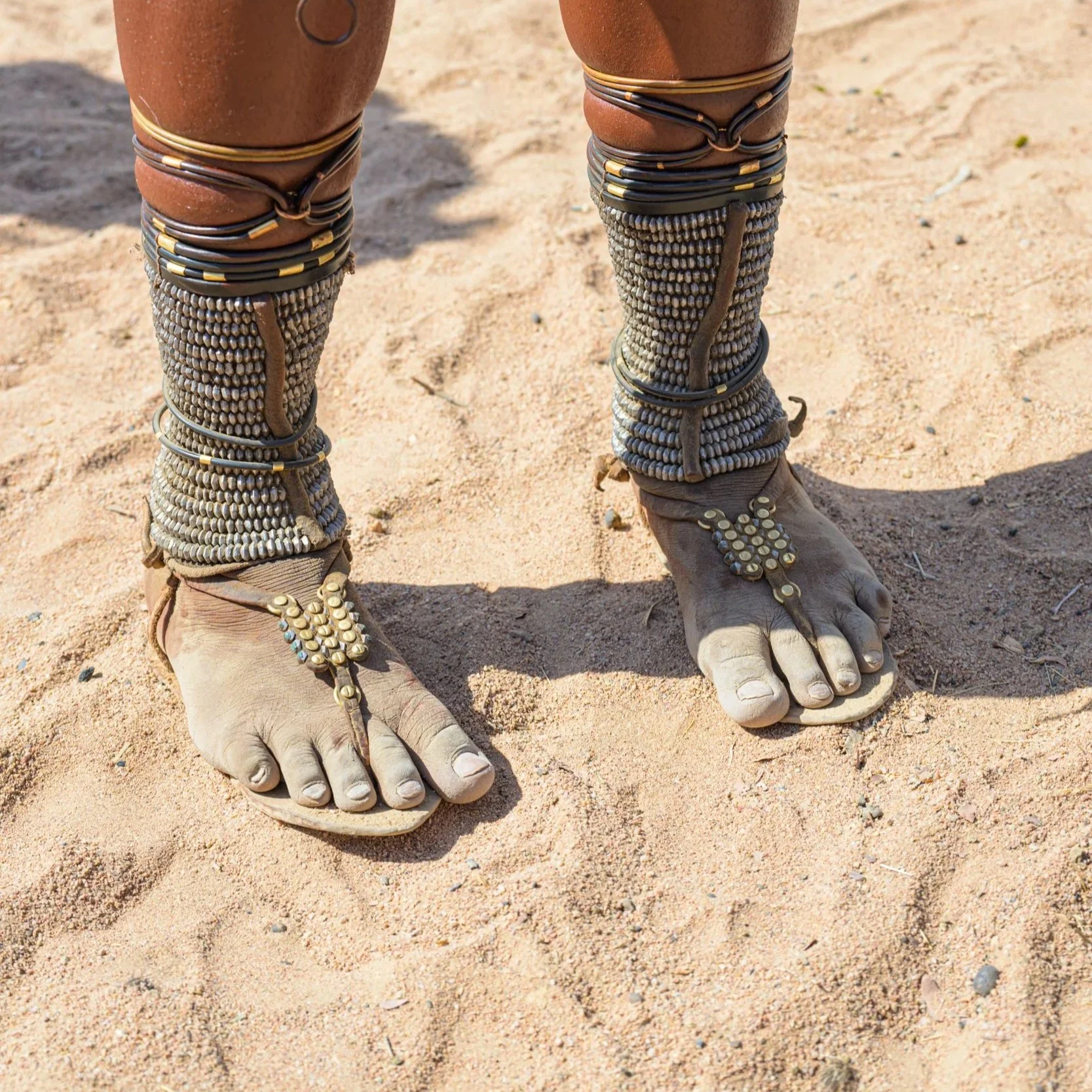
NORTHERN NAMIBIA
MOTORCYCLE TOUR
AN 11 DAY OFF-ROAD ADVENTURE
THROUGH NAMIBIA
July 22nd - August 1st
DATES:
Windhoek, Walvis Bay, Etosha National Park, Damaraland, Hemba Village, Skeleton Coast, Cape Cross
HIGHLIGHTS:
Windhoek, Namibia
DAYS:
11 days, 10 nights
START/END:
Intermediate
EXPERIENCE LEVEL:
Adventure Bike, Dual Sport, Scramblers
RECOMMENDED BIKES:
MOTORCYCLE RENTAL:
Yamaha Tenere 700
GROUP SIZE:
SUPPORT:
max 10
Team Medic, Technician, Off-road Instructor, Adventure Guide, Support vehicle and Trailer
10 Nights accommodation in luxury lodges, some meals, all fuel, permits, Game Drives, Cultural visits like Himba & Bushman, event merch, welcome packet, Motorcycle Rental, GPX routes and event photographer.
INCLUDES:

THE ADVENTURE
This is the ride where the map fades and the real adventure begins. We’ll carve our way through the raw beauty of Damaraland and Kaokoland, two of Namibia’s most untouched frontiers. Out here, vast desert plains stretch forever, ancient volcanic peaks like the Brandberg Massif rise out of the earth, and desert-adapted elephants and black rhinos move silently across the land.
Kaokoland is as remote as it gets—rolling hills, endless plains, and dry riverbeds that test both rider and machine. Along the way, we’ll encounter the proud Himba, Bushman, and Herero tribes, where timeless traditions still shape daily life. It’s isolation in its purest form, where the changing light of dawn and dusk paints the land in colours you’ll never forget.
With the freedom of motorcycle travel, every day is about soaking in Namibia’s wild essence. The ride is rugged, the landscapes unfiltered, but at night we retreat to luxury lodges that offer the perfect balance of comfort and connection. And when the dust settles, we’ll cap it all off with a visit to the legendary Etosha National Park—a final reminder of why this adventure is one you’ll carry with you forever.
THE BONAFIDE SPIRIT OF ADVENTURE
We've always been of the mindset that Bonafide Moto Co. curates adventures, rather than tours. The reasoning is simple – we're adventurers at heart.
To us, adventures come with ups and downs along the way. Some days are easy, while others will challenge you. Either way, you’ll reach your journey's end with a feeling of real accomplishment.
Bonafide Moto Co. adventures are carefully designed to encapsulate the true spirit of adventure travel. They take you along paths unknown, push the limits of your skills, make you work for your reward – and most of all, bring like-minded people together.
Adventures are all about a team effort. Each person finds a role, assisting others when they need help and knowing that each of us is in this together.
We pride ourselves on having the ability to create this camaraderie, with many of our guests returning year-on-year to rekindle those lasting friendships at the end of every day around the fire.
If you’re looking for an easy outride – this one isn’t for you. If you’re looking for a life-changing motorcycle adventure that will challenge you, make you part of a team, and help you grow as an individual – this is your next adventure and we look forward to hosting you!

ITINERARY
Actual stops and locations are subject to change.
Walvis Bay
We kick things off at the Walvis Bay Salt Pans—a place that looks more like another planet than the edge of Namibia’s coast. Stretching out in a patchwork of shallow ponds, this is one of Africa’s largest salt works, where ocean water meets sun and wind to create endless white plains of crystal salt.
It’s a striking sight—the blinding white against the deep Namibian blue sky—made even more alive by the flocks of flamingos and migratory birds that call it home. For riders, photographers, and anyone who craves wild beauty, the salt pans set the tone: surreal, raw, and unforgettable.
Skeleton Coast
Few places on earth feel as raw and untamed as Namibia’s Skeleton Coast. Stretching from the Kunene River in the north to the Swakop River in the south, this is a land of fog, shipwrecks, and shifting sands—a coastline so unforgiving it’s claimed countless vessels, and rightfully earned its ominous name.
Riding here is like stepping into another world. Vast dunes roll into windswept beaches, and the rusting bones of old ships lie half-buried in the sand, slowly disappearing into time. But for all its desolation, the Skeleton Coast is alive—desert-adapted elephants and even lions roam these harsh spaces, alongside raptors and shorebirds that thrive on the edge of land and sea.
Epupa Falls
At the edge of Namibia, where the Kunene River carves the border with Angola, we find Epupa Falls—a raw, thundering stretch of cascades that crashes for over a kilometre, with the biggest drop plunging nearly 40 meters. It’s wild, untamed, and breathtaking all at once.
The landscape here is rugged and dramatic, dotted with ancient baobab trees and lush vegetation that thrives in the mist rising off the falls. It’s a stark contrast to the arid land around it, and the sound alone—the roar of water against rock—reminds you of nature’s sheer power.
For the Himba people who live nearby, this place holds deep cultural meaning. For us as riders, it’s a highlight of the north—whether you’re standing in awe at the lookout, cooling off in natural pools, or simply soaking in the spirit of a place where culture and wilderness collide.
Etosha Game Drive
No adventure through northern Namibia is complete without a game drive in Etosha National Park—one of Africa’s most iconic wildlife reserves. At its core lies the Etosha Pan, a vast salt flat so massive it can be seen from space, surrounded by endless savannah and woodlands teeming with life.
On safari here, every turn of the track holds the promise of something extraordinary: elephants moving in slow, deliberate silence; lions stretched out in the heat of the day; leopards ghosting through the trees; rhinos kicking up dust; and herds of zebra and giraffe drifting across the horizon. The birdlife is just as rich, adding color and sound to the wilderness.
In the dry season, waterholes become the stage for unforgettable encounters as predator and prey gather in the same space, bound by the need for water. Whether it’s the first light of dawn, the golden calm of dusk, or the heat of the day, Etosha delivers raw, wild Africa at its finest.
Bushman Village
A visit to a Bushman village is more than a stop on the journey—it’s a step back into one of humanity’s oldest living traditions. The San people, often called the world’s original storytellers, have lived as hunter-gatherers for thousands of years, their lives shaped by an intimate connection with nature.
Here you’ll see their knowledge in action: how to track wildlife across the sand, how to read the land, and how every plant has a purpose—medicine, food, or survival. Around the fire, stories are passed down through song, dance, and rhythm, preserving lessons that have carried their culture across generations.
It’s not about watching from the outside—it’s about learning, listening, and sharing space with a people whose way of life is rooted in harmony with the environment. Time with the San isn’t just a cultural encounter; it’s a reminder of what it means to live simply, resourcefully, and deeply connected to the land.
Namib Naukluft
The Namib isn’t just a desert—it’s one of the oldest and most iconic on earth. Stretching inland from the Atlantic and spanning nearly 50,000 square kilometres across Namibia, Angola, and South Africa, this vast wilderness is as harsh as it is breathtaking.
Despite its arid heart, the Namib is alive with plants and animals found nowhere else in the world—species that have adapted in remarkable ways to survive in a place defined by extremes.
Scattered across its expanse are some of Namibia’s greatest highlights: the towering dunes of Sossusvlei, the narrow chasm of Sesriem Canyon, the prehistoric Welwitschia Trail, the wild beauty of Sandwich Harbour, the rugged Naukluft Mountains, and the winding Kuiseb Canyon.
This is the desert that defines Namibia—a place of silence, scale, and stories written in sand.
Zeila Wreck
Rolling up the Skeleton Coast toward Henties Bay, we pull over for a closer look at one of Namibia’s most haunting landmarks—a rusting fishing trawler that ran aground back in 2008. What was once headed for scrap has now been fully claimed by the Atlantic, its twisted steel slowly dissolving into the ocean’s grip.
Against the wild backdrop of crashing surf and endless horizon, the wreck is both eerie and beautiful. Over the years it’s become an artificial reef, drawing in marine life and seabirds, and standing as a stark reminder of how nature always has the final say. It’s a scene that begs for a photo, but more than that—it’s a moment to feel the raw, untamed spirit of this coast.
Herero Village
On this journey, we cross paths with Namibia’s proud indigenous cultures, each carrying traditions shaped by centuries of life in this land. Among them are the Herero, found mainly in central and eastern Namibia.
Cattle are at the heart of Herero life—the measure of wealth, status, and survival. Their culture is deeply tied to the herds they tend, and that connection is written into every aspect of daily life. But what strikes most visitors first is the Victorian-style dresses worn by Herero women. Known as Otjikaiva, these bold, sweeping gowns are more than just attire—they’re a statement of cultural pride and resilience, carried forward from the early 20th century into today.
Kunene River
Winding for nearly 1,000 kilometres, the Kunene River is both a lifeline in one of Africa’s driest regions and a natural border between Namibia and Angola. Its waters carve through rugged terrain, feeding dramatic landmarks like Epupa Falls and Ruacana Falls, where the river explodes into breathtaking cascades.
Along its banks, life flourishes—lush pockets of green in a land of dust and rock. Communities draw their survival from it, wildlife gathers at its edges, and yes, crocodiles lurk in its waters (so think twice before diving in).
The Kunene is more than a river—it’s a force. Out here, it’s the contrast that makes it unforgettable: desert all around, yet this relentless ribbon of water keeps everything alive.
Windhoek
Windhoek, Namibia’s capital, is a city of contrasts—modern yet steeped in history, relaxed yet buzzing with life. Home to around half a million people, it serves as the country’s political, cultural, and economic heartbeat. Founded during German colonial rule in the 19th century, Windhoek has grown into a city known for its clean streets, modern feel, and welcoming energy, setting it apart from many other African capitals.
Beyond the surface, Windhoek is alive with a thriving music and art scene that’s earned global recognition. Even if we’re only here for a day, it’s worth soaking in the atmosphere before the road north calls. It’s the perfect place to reset, gather the crew, and get ready for the adventure that lies ahead.
Sand Dunes
Namibia’s sand dunes are alive with color, shifting from pale gold to deep, fiery orange as the sun moves across the sky. The rich hues come from iron oxide in the sand—nature’s paintbrush working on a massive canvas.
But these dunes are more than just stunning landscapes. They’re a living ecosystem, home to antelope moving gracefully across the ridges, birds riding the thermals, and desert-adapted creatures like the Namib Beetle, which has mastered the art of survival in one of the harshest environments on earth.
It’s a reminder that even in the driest, most unforgiving places, life finds a way—and the beauty of the desert lies not just in its scale, but in its resilience.
Swakop Moon Valley
Just outside Swakopmund lies a landscape that feels like stepping onto another planet—Swakop Moon Valley. Shaped over millions of years by the Swakop River, its rugged gullies and stark ridges create a terrain so surreal it looks more lunar than earthly.
At first glance it seems lifeless, but look closer and you’ll find a fragile ecosystem clinging to survival. Most famous is the Welwitschia mirabilis, a prehistoric plant that thrives here against all odds—some specimens are over 1,500 years old. It’s proof that even in the harshest environments, life not only endures but tells stories that stretch back through the ages.
Moon Valley isn’t just a stop—it’s a reminder of nature’s artistry, resilience, and raw, otherworldly beauty.
Cape Cross
Not far up the Skeleton Coast lies Cape Cross, home to one of the largest Cape fur seal colonies on the planet—over 200,000 strong. It’s a wild, chaotic, and unforgettable scene.
The beach is alive with movement and sound: pups wobbling their first steps, bulls crashing into each other in brutal battles for dominance, and a constant chorus of barks and growls that carries for miles. The smell hits you first, the sound never stops, and the sight of so much raw life packed onto one stretch of coast is nothing short of overwhelming.
It’s wild Namibia in its purest form—raw, noisy, and completely unforgettable.
Himba Village
A visit to a Himba village is like stepping into another rhythm of life—one that has resisted the pull of modernity and stayed true to its roots. The Himba, one of Africa’s last semi-nomadic tribes, are instantly recognizable for their striking appearance and time-honored traditions.
Here we witness daily life unfolding much as it has for generations. Women prepare their signature ochre-and-animal-fat mixture, a beauty ritual that gives their skin its deep red hue and symbolizes their bond with the earth. Cattle herding remains at the center of their economy and culture, shaping not just survival but identity. Every hairstyle, every piece of attire carries meaning, telling stories of age, status, and heritage.
Spending time with the Himba isn’t about tourism—it’s about connection. It’s a chance to listen, to learn, and to glimpse the strength of a people whose way of life is inseparable from the land they call home.
Ruacana Falls
Up on the Kunene River sits Ruacana Falls, a waterfall that roars to life with unbelievable power during the rainy season. From December to April, when the river is at its fullest, the water crashes over a broad horseshoe-shaped cliff, dropping more than 120 meters into the gorge below—a wall of thunder and spray you can feel in your chest.
In the dry months, the flow eases off, sometimes down to a trickle, exposing the raw rock formations beneath. It’s a reminder of how dramatically this landscape shifts with the seasons. Alongside the falls, you’ll also find Namibia’s largest hydroelectric station—a balance between wild nature and human necessity.
Whether it’s birdwatching along the riverbanks, exploring the rugged terrain, or just standing in awe at the edge of the gorge, Ruacana is another place where Namibia shows off its untamed spirit.
Erongo Mountains
Rising out of the desert like something from another world, the Erongo Mountains are one of Namibia’s most dramatic landscapes. Formed by volcanic activity some 130 million years ago, this circular range is a maze of towering peaks, massive boulders, and winding valleys that feel both ancient and alive.
The region is a haven for biodiversity—home to unique plant and animal species found nowhere else. But it’s not just nature that makes Erongo special. Hidden among the rocks are thousands of San rock art sites, offering a window into the spiritual and everyday lives of the people who once called this land home.
It’s a place where geology, wildlife, and human history collide—a destination that feels raw, sacred, and unforgettable.
Local Damara Tribe
The Damara are among Namibia’s oldest known inhabitants, with roots that run deep through the country’s history and landscapes. Traditionally, they’ve lived in the northwest—around the Brandberg, Spitzkoppe, and the Erongo Mountains—lands as rugged and enduring as their culture.
Their language, Khoekhoegowab (try wrapping your tongue around those clicks!), is shared with the Nama people and instantly recognizable for its unique sounds. Beyond language, the Damara have long been known for their artistry—crafting jewelry from ostrich eggshells, working leather, and shaping metal into tools and ornaments.
Over centuries, they’ve adapted and shifted, facing challenges of displacement and change, yet their heritage and creativity remain a vital part of Namibia’s cultural fabric. Meeting the Damara is meeting resilience itself—an ancient people who continue to shape and celebrate their place in this land.
Luxury Accommodation
After a full day carving through Namibia’s wild landscapes, the ride winds down with something just as memorable—luxury lodges tucked deep into the scenery. Each stay has been handpicked to strike the perfect balance between indulgence and authenticity.
Think stylish rooms with wide-open views, gourmet meals that taste even better after a day in the saddle, and quiet spaces where the only soundtrack is the wind or a distant call of wildlife. These aren’t just overnight stops—they’re sanctuaries that recharge you for the road ahead.
It’s comfort without losing the connection to the wild, giving you the best of both worlds: rugged adventure by day, refined relaxation by night.
ADVENTURE INFO
PRICING
$6,500 - Motorcycle Rental Included
$4,800 - Bring your own motorcycle
35% Deposit Required to secure booking
INCLUDES
Your ride: Yamaha Ténéré 700
Luxury Accommodations
Meals (except first and last nights dinners)
Experienced guide
All fuel during the tour
Support truck 24/7
Transfer from/to Windhoek Int. Airport
Permits
Event Photographer
Game drives (safari)
Cultural visits like Himba & Bushman
NOT INCLUDED
Insurance
Flights
Riding gear
Drinks outside the meal options
Visa Documentation
RIDER REQUIREMENTS
SKILL LEVEL: Intermediate. No Beginners.
Must consider yourself to be a ‘confident’ off-road rider and have experience with multi-day trips.
Namibia can be a challenging place to ride and you need to be prepared for tough days on the bike.
RECOMMENDED TRAINING: Riding in sand is a huge skill to learn prior to coming to Namibia. If you have the opportunity to do so it will set you up for success. We will provide you with our 5 essentials to riding in sand.
NAVIGATION: All riders will be required to have some form of navigation mounted to their bike at all times.
HAVE MORE QUESTIONS ABOUT THIS TRIP?


























STAY SAFE OUT THERE
Bonafide Moto Co is a Safe travel partner with Global Rescue and recommends that all our guests purchase travel insurance to cover trip cancellation, medical emergencies, field evacuation, emergency assistance and travel delays.
The Global Rescue team can advise regarding travel insurance and emergency services.

